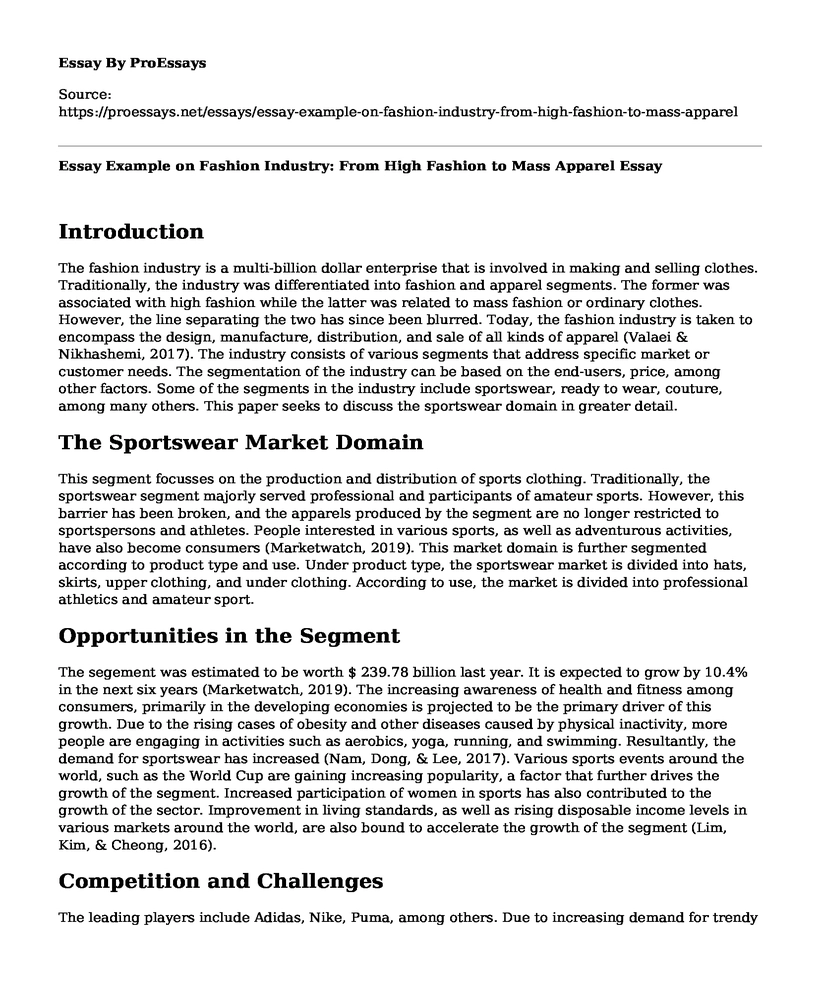Introduction
The fashion industry is a multi-billion dollar enterprise that is involved in making and selling clothes. Traditionally, the industry was differentiated into fashion and apparel segments. The former was associated with high fashion while the latter was related to mass fashion or ordinary clothes. However, the line separating the two has since been blurred. Today, the fashion industry is taken to encompass the design, manufacture, distribution, and sale of all kinds of apparel (Valaei & Nikhashemi, 2017). The industry consists of various segments that address specific market or customer needs. The segmentation of the industry can be based on the end-users, price, among other factors. Some of the segments in the industry include sportswear, ready to wear, couture, among many others. This paper seeks to discuss the sportswear domain in greater detail.
The Sportswear Market Domain
This segment focusses on the production and distribution of sports clothing. Traditionally, the sportswear segment majorly served professional and participants of amateur sports. However, this barrier has been broken, and the apparels produced by the segment are no longer restricted to sportspersons and athletes. People interested in various sports, as well as adventurous activities, have also become consumers (Marketwatch, 2019). This market domain is further segmented according to product type and use. Under product type, the sportswear market is divided into hats, skirts, upper clothing, and under clothing. According to use, the market is divided into professional athletics and amateur sport.
Opportunities in the Segment
The segement was estimated to be worth $ 239.78 billion last year. It is expected to grow by 10.4% in the next six years (Marketwatch, 2019). The increasing awareness of health and fitness among consumers, primarily in the developing economies is projected to be the primary driver of this growth. Due to the rising cases of obesity and other diseases caused by physical inactivity, more people are engaging in activities such as aerobics, yoga, running, and swimming. Resultantly, the demand for sportswear has increased (Nam, Dong, & Lee, 2017). Various sports events around the world, such as the World Cup are gaining increasing popularity, a factor that further drives the growth of the segment. Increased participation of women in sports has also contributed to the growth of the sector. Improvement in living standards, as well as rising disposable income levels in various markets around the world, are also bound to accelerate the growth of the segment (Lim, Kim, & Cheong, 2016).
Competition and Challenges
The leading players include Adidas, Nike, Puma, among others. Due to increasing demand for trendy and fashionable sportswear, the players in the segment developing innovative products and solutions such as through the use of microfibers and insulators to satisfy the needs of the consumers (Bait, et al., 2019). The players employ different strategies, such as partnerships and acquisitions, to overcome competition. For instance, in 2014, Adidas entered into a ten-year partnership with Manchester United (Wilson, 2014). Infiltration of the market by counterfeit products is the main challenge facing the segment. The counterfeits are low-priced and hence hampers the sale of branded sportswear. Moreover, the counterfeits are inferior in quality and thus hurts the brand image of the players (Achu, 2015).
Conclusion
The sportswear market domain is one of the fastest-growing segments of the multi-billion dollar fashion industry. The increasing participation in sporting and physical activities, as well as the rising disposable income levels in various markets, are some of the opportunities in the segment. However, to overcome the intense competition and thrive, the players must develop innovative solutions to the needs of the customers. They must also overcome the challenge posed by counterfeits.
References
Achu, D. (2015). Analyzing Purchase Intentions of Counterfeit Luxury Brands: Consumers' Attitudes toward the Purchase of Counterfeit Sportswear Brands in Cameroon. Society of Management and Behavioural Sciences Canada (SMBS Canada), 5.5(6), 27. Retrieved from http://www.smbscanada.org/ijmcs-pj/Volume%205%20issue%205-6.pdf#page=32
Bait, S. H., Shrivastava, N., Behera , J., Ramakrishnan, V., Dayal, A., & Jadhav, G. (2019). Development of sportswear with enhanced moisture management properties using cotton and regenerated cellulosic fibres. Indian Journal of Fibre & Textile Research (IJFTR), 44(1), 24-30. Retrieved from http://op.niscair.res.in/index.php/IJFTR/article/view/17093
Lim, C. H., Kim, K., & Cheong, Y. (2016). Factors affecting sportswear buying behavior: A comparative analysis of luxury sportswear. Journal of Business Research, 69(12), 5793-5800. Retrieved from https://www.sciencedirect.com/science/article/pii/S0148296316304271
Marketwatch. (2019, February 20). Sportswear Market - Global Industry Analysis, Size, Share, Growth, Trends and Forecast 2019 - 2025. Retrieved from Marketwatch: https://www.marketwatch.com/press-release/sportswear-market-global-industry-analysis-size-share-growth-trends-and-forecast-2019---2025-2019-02-20
Nam, C., Dong, H., & Lee, Y. A. (2017). Factors influencing consumers' purchase intention of green sportswear. Fashion and Textiles, 4(1), 2. Retrieved from https://fashionandtextiles.springeropen.com/articles/10.1186/s40691-017-0091-3
Valaei, N., & Nikhashemi, S. R. (2017). Generation Y consumers' buying behaviour in fashion apparel industry: a moderation analysis. Journal of Fashion Marketing and Management: An International Journal, 21(4), 523-543. Retrieved from https://www.emeraldinsight.com/doi/abs/10.1108/JFMM-01-2017-0002
Wilson, B. (2014, July 14). Manchester United and Adidas in PS750m deal over 10 years. Retrieved from BBC News: https://www.bbc.com/news/business-28282444
Cite this page
Essay Example on Fashion Industry: From High Fashion to Mass Apparel. (2023, Feb 11). Retrieved from https://proessays.net/essays/essay-example-on-fashion-industry-from-high-fashion-to-mass-apparel
If you are the original author of this essay and no longer wish to have it published on the ProEssays website, please click below to request its removal:
- Change, Growth, and Development of Wing Biddlebaum/Adolph Myer and Kacem
- Smalls Jazz Club Concert Review
- Essay Sample on Heavy Metal Music
- Essay Sample on Girl With a Mandolin: Analytic Cubist Painting by Pablo Picasso
- Essay Example on Southern & Northern Renaissance Art: Secular & Religious Differences
- Film Analysis Essay on Do the Right Thing: Condemning Violence and Police Brutality
- Essay Example on Phenomenal Nancy Pelosi, America's Most Powerful Woman Speaker







